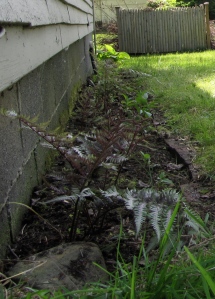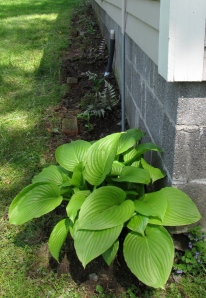AS ANYONE WHO HAS GARDENED for more than a season knows, plants have an uncanny way of organizing themselves, with or without our help. The lamb’s ear pushes its way into the lawn, a stray bleeding heart shoots up from beneath the woodpile, the bergamot surrounds the wild thistle.
Several years ago, I dug up some surplus painted ferns flourishing on one side of the garage, and could not bear to throw them away. I made a narrow trench beneath the eave on the building’s opposite side and spaced out ferns along it, thinking it would make a lush border when it eventually filled in.
 Narrow though it is, like all gardens it is a dynamic place. The half-buried bricks framing the space break down a little more every year, slowly changing the soil’s look and composition. The dirt, though, remains rich with earthworms. It retains moisture well, which has held growth back some during this wet, cloudy spring, but which will sustain the garden well through August.
Narrow though it is, like all gardens it is a dynamic place. The half-buried bricks framing the space break down a little more every year, slowly changing the soil’s look and composition. The dirt, though, remains rich with earthworms. It retains moisture well, which has held growth back some during this wet, cloudy spring, but which will sustain the garden well through August.
I pull the inevitable grass and weeds annually to create an aerated bed, which the weeds aggressively seek to regain, advancing stealthily, steadily, like an ocean tide. But other species can come into play, too, in this pumped-up loam — if I add them or if they can get there on their own. Without my aid or intention, a dozen or so buddleia, or butterfly bush, have moved right in, despite the fact that previously the nearest specimen was more than twenty feet away, across a lawn, in full sun.
The tall, mid-summer buddleia should go well with the low, early-season painted fern, in complementary purplish tones, and protecting the ferns from summer heat. Still, I never would have thought to plant buddleia in this relatively shady spot. Nor would I have added the single (for now) beardtongue, although its purple-red foliage and pastel lilac flowers are also harmonious, as will be the fall blossoms of several random lobelia. Both species are prolific elsewhere in the yard.
 Other than the ferns, my only contribution was the hosta at one end, planted for its unusual fragrance. Its flowers add a dash of white, and its smooth, heart-shaped leaves contrast nicely with the ferns’ feathery foliage. (There also is a sole survivor of my earlier attempt to establish a colony of lily-of-the-valley, and a lone foxglove.)
Other than the ferns, my only contribution was the hosta at one end, planted for its unusual fragrance. Its flowers add a dash of white, and its smooth, heart-shaped leaves contrast nicely with the ferns’ feathery foliage. (There also is a sole survivor of my earlier attempt to establish a colony of lily-of-the-valley, and a lone foxglove.)
The garden is not done evolving, but it is shaping up nicely for the year. It wasn’t exactly my idea, but I’m happy to play my part.




Nice, really nice…
Isn’t it great to watch things take shape in the garden? I have that same japanese painted fern & it gets better each year.